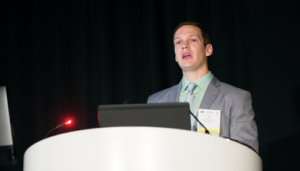Noble drives down completion time for Tamar 8 well by adopting new designs for temporary P&A, BHAs
In previous wells, six different BHAs were required to complete the well, while Tamar 8 required only three
By Kelli Ainsworth Robinson, Associate Editor

Since Noble Energy’s Tamar field offshore Israel was brought online in 2013, the natural gas produced from the field has provided 60% of Israel’s electricity. To continue meeting the country’s gas demand, Noble announced in 2016 that it would drill the Tamar 8 well. This provided Noble with an opportunity to optimize the well’s completion design and methodology.
In a presentation on 6 March at the 2018 IADC/SPE Drilling Conference in Fort Worth, Texas, Ian Magin, Deepwater Completions Engineer for Noble, said that the operator made key changes on Tamar 8, including drilling and underreaming on the same trip and developing a new plan for temporary plug-and-abandonment (P&A)between drilling and completing the well. This approach to completions “allowed us to save approximately five days of rig time without compromising our well performance,” Mr Magin said. “The team is strongly considering using this same approach moving forward on some similar wells in the region.”
The Tamar field was discovered in 2009. In Tamar Phase 1, five wells were drilled in water depths of 5,500 ft and tied back to a shallow-water production platform. The 93-mile tieback was the longest ever at the time, Mr Magin said. The first five Tamar wells average a combined daily production of between 1 billion and 1.2 billion cu ft of natural gas, with each well producing an average of 260 million cu ft/day.
When Noble decided to drill and complete Tamar 8, the company examined previous field completions and found that the well reentry, fluid displacement and drilling and underreaming required six bottomhole assembly (BHA) trips. These six trips comprised 40% of the completion rig time. “We decided, as a team, that this is where we really wanted to focus our efforts,” Mr Magin said.
The temporary P&A design for the first Tamar wells consisted of a tapered 10 ¾-in. by 9 5/8-in. casing set as a liner tieback. To make the reentry process smoother, Noble set Tamar 8 with V0-rated bridge plugs, and the production casing was run as a long string. This allowed the operator to use fewer plugs, which meant fewer plugs had to be drilled out. The company also chased the production cement job in Tamar 8 with brine, instead of mud, which had been used on the earlier wells. “As soon as the completions team moved onto the well, we didn’t need to deal with any mud,” Mr Magin said. “This saved us a lot of time from having to clean our pits and all of our lines from the mud that would’ve been on the rig beforehand.”
Further, Noble optimized the drill out and underreaming process on Tamar 8. “On Tamar Phase 1, it took us six runs from where we were reentering the well to where we were displacing the brine before our open-hole gravel pack,” Mr Magin said. In Phase 1, well reentry began once the subsea tree was installed and the BOPs were tested. The first run required a 9 ¼-in. wellbore cleanout BHA that consisted of cement mill, spiral mill, scrapers, brushes, magnets and a drill collar to drill out the surface plugs set in 10 ¾-in. production casing. A new wellbore cleanout BHA was required to drill out the next cement plug, which was set in 9 5/8-in. casing just above the liner hanger inside the tieback. Twice-recycled reservoir drill-in fluid (RDIF) was used to drill out this plug, along with the float collar, shoe and shoe track. The full well was then circulated with the RDIF.
After that, a third wellbore cleanout BHA was run to pick up a test packer, then run to the 9 5/8-in. casing shoe. Then, the twice-recycled RDIF was displaced with a once-recycled RDIF. An open-hole BHA that consisted of a bit and measurement-while-drilling (MWD) tools drilled out the casing shoe, shoe track and 45 m of reservoir while the once-recycled RDIF was circulated. The fifth BHA, the underreamer BHA, was run to expand the open-hole section from 8 ½ in. to 12 ¼ in. The underreamer was activated by pumping a new RDIF. The final cleanout BHA was then run to total depth. After that, the RDIF was displaced from the open hole and the first 150 m of casing with a solids-free RDIF.
Tamar 8 required only three BHA runs. The well was reentered after the installation of the subsea tree and latching up of the BOP. The upper packer retrieval BHA was run to the wellhead to test the BOP. Once testing was complete, the BHA was run with seawater in the riser to just above the upper suspension packer. The upper packer was released and brought to surface. The lower packer retrieval BHA was then run to the lower suspension packer and retrieved the packer. The third BHA was run with drilling, underreaming and cleanup tools. Drilling, underreaming and cleanout were performed in one trip, with one BHA.
For Tamar 8, Noble also switched to a ball-drop-activated underreamer to save a BHA trip by allowing the operator to get a final brine displacement before open-hole gravel packing in the same trip. “During Tamar Phase 1, we used a hydraulically activated underreamer, which prevented us from being able to displace during the same trip,” Mr Magin said. “A dedicated trip was made for the displacement, otherwise the underreamer arms would’ve opened.”
By reducing the number of BHA trips required to reenter, clean out and underream the well, Noble was able to save an estimated five days of rig time. Shaving five days off the completion time translated to a cost saving between $5 million and $7 million, according to Noble. Further, the well’s performance was on par with other wells in the field, with a production rate of approximately 250 million cu ft/day. “Not only were we able to save time and money on the operations, but it didn’t negatively impact our (production) performance,” Mr Magin said. DC
For more information about this project, please see IADC/SPE 189637, “Optimizing the Deepwater Completion Process: Case History of the Tamar 8 Completion Design, Execution and Initial Performance – Offshore Israel,” presented at the 2018 IADC/SPE Drilling Conference, 6-8 March, Fort Worth, Texas.





